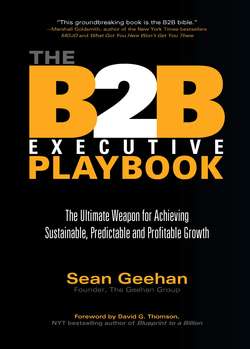Читать книгу The B2B Executive Playbook - Sean Geehan - Страница 15
На сайте Литреса книга снята с продажи.
Relevant Innovation
ОглавлениеThe ability to produce innovative products and services is a much-vaunted corporate quality, but innovation initiatives also consume a huge amount of corporate resources, often with little or no return. Consider Xerox’s famed Palo Alto Research Center (PARC), which pioneered many innovations, including the mouse and the graphical user interface that produces the windows and icons you see on your computer monitor. Xerox funded these innovations, but never successfully commercialized them. The lesson of PARC for B2B companies is that the only product and service innovation worth pursuing is innovation that is both relevant to your customers and for which they will pay a premium.
Relevant innovation also goes beyond run-of-the-mill improvements to the features and functions of existing products. Most “next generation” products companies bring to market aren’t game-changing enablers of business transformation. Think of the many versions of Windows that Microsoft has released over the years. How many represented relevant innovation and how many found a market simply because they were preloaded on new PCs?
Historically, B2B companies have struggled to produce relevant innovation. Research shows that new product success rates are only in the 30-40 percent range. One reason for this poor performance is that B2B companies have followed the B2C mindset in developing new products—they focus on the needs and desires of end users. The problem, of course, is that end users are not usually the decision makers in the B2B world. Further, although the B2C approach can work for product improvements and updates, end users rarely provide the level of feedback needed for B2B companies to produce new offerings containing the degree of business innovation and transformation that motivates executive decision makers to buy.
At Wells Fargo, executive customers helped transform the bank’s innovation focus. Executive customers came up with the idea of a mobile portal so that CFOs could easily access important information about their accounts when they were away from their computers. The Wells Fargo executive customer collective, a group of 15 financial leaders drawn from the bank’s most important commercial accounts, assisted throughout the development process—helping define the main components of the portal, performing reviews, serving as beta testers, and providing input and feedback on the go-to-market strategy.
When executive customers are involved in the entire innovation process, the chances of producing a hit are significantly increased. Similarly, they can identify a potential flop early in the process. Due to the success of financial programs and services in the consumer and small business markets, such as Intuit’s Quicken and QuickBooks, Wells Fargo considered offering commercial accounting services and delivering them online via their portal. It seemed a natural extension, but when the company vetted the idea with its executive customers, the response was overwhelmingly negative. They said they would not buy accounting services from the bank; what they really wanted was an easier way to integrate their existing accounting packages with their accounts. Their feedback saved Wells Fargo time, money, and credibility in the marketplace.
Relevant innovation extends to mergers and acquisitions (M&A) too, because often B2B companies buy innovation. Therefore, executive customers can play a valuable role in the M&A process as well. Oracle, for example, has acquired more than 60 companies to build out their offerings since 2005. Executive customers helped the company identify solution gaps and even suggested acquisition targets that weren’t on its radar. “Whether we develop it or acquire innovation, it must be relevant to the customer’s world,” says Jeb Dasteel. “Our executive customers make sure we invest properly.”
HCL Technologies has tapped executive customers to drive its efforts to create an innovative new business model. “Our executive customers have not only helped us create innovative products and services, but even more importantly, they have driven the transformation of our business model,” says Anubhav Saxena, global vice president of marketing and strategy of HCL’s ISD unit. “With so many directions and paths we could pursue, the clarity and direction our executive customers have provided is unmatched. Redefinition of our value proposition on Business Aligned IT, conceptualization and eventual co-development of HCL’s Gold Standard, and the reinforcement of our onshore/right-shore Global Delivery Model investments including brand enhancing recommendations are some examples.”
